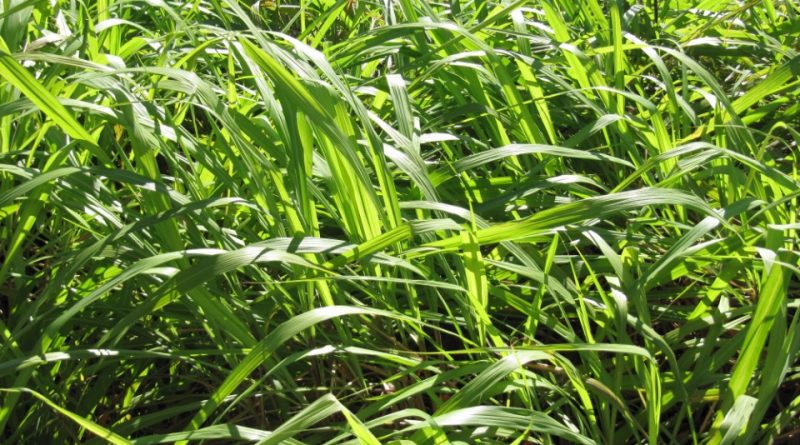Cymbopogon winterianus
Cymbopogon winterianus
The Java Lemongrass (Cymbopogon winterianus Jowitt ex Bor) is a herbaceous species belonging to the Poaceae family.
Systematics –
From the systematic point of view it belongs to the Eukaryota Domain, Kingdom Plantae, Magnoliophyta Division, Liliopsida Class, Poales Order, Poaceae Family, Panicoideae Subfamily, and therefore to the Cymbopogon Genus and to the C. winterianus Species.
The terms are synonymous:
– Cymbopogon nardus mahapengiri (L.) Rendle.
Etymology –
The term Cymbopogon comes from the Greek κύμβη cýmbe cup, cup, boat and πώγων pógon barba: reference to the arrangement of the hairy-looking cobs.
The specific winterianus epithet derives from the name of Winter, which in the nineteenth century contributed to its recognition as a separate species.
Geographic Distribution and Habitat –
Cymbopogon winterianus is a species native to Southeast Asia, introduced later in Indonesia, we find it in Indonesia, Vietnam, Nepal, in various regions of Africa and in the Antilles.
Its natural habitat is not known as the plant is not found in its natural state.
Description –
Cymbopogon winterianus is a herbaceous, robust, aromatic, evergreen, perennial plant, which forms tufts with numerous erect culms deriving from a short rhizome.
The culms can be up to 2.5 meters high.
The leaves are long, lanceolate, narrow, with red outlines and hollow stems, bulbous at the base.
Cultivation –
The Java Lemongrass is a plant of the humid and lowland tropics, where it is found at altitudes up to 1,000 meters. It grows best in areas where annual daytime temperatures are between 22 and 30 ° C but can tolerate 16 – 36 ° C.
It prefers average annual rainfall of between 1,500 and 2,200 mm, but tolerates between 1,000 and 4,100 mm, and grows best in dry to moist, well-drained soil and in a location in full sun. Some forms of the plant can tolerate waterlogging and prefers a pH between 5 and 6, tolerating 4.3 – 8.
At the crop level, the first cut is usually made 180-270 days after sowing, the next harvest is done every 90-120 days and the harvest lasts 4-5 years, as yields are constantly decreasing.
Average yields of essential oil are generally between 45 and 110 kg / Ha.
Cultivars with yields of up to 385 kilos per hectare have been developed in India.
As for the propagation, given the difficulty in forming seeds by this plant, this occurs by division of the tufts, with the divisions that root quickly and form new stems within a month.
Customs and Traditions –
This species is closely related to Ceylon lemongrass (Cymbopogon nardus (L.) Rendle) and the two species have sometimes been treated as different forms of the same species, such as Cymbopogon nardus mahapengiri (this species) and Cymbopogon nardus lenabatu (Ceylon lemongrass).
The plant is often cultivated, mainly in Java and other parts of Southeast Asia, for the essential oil contained in its leaves. This oil is widely used in the perfume industry. This species produces up to twice as much essential oil as Cymbopogon nardus (mainly grown in Sri Lanka) and the oil is of better quality.
This plant is used for some medicinal uses.
Leaf packs are used to treat minor cuts and bruises or as a wormer and treatment for internal ailments. They are moderately astringent and gastric.
In general, the essence of Java lemongrass, which repels mosquitoes and cures their bites, is anti-infective, antibacterial, antifungal and anti-inflammatory. For example, it is recommended in ENT for angina as it is anti-inflammatory, analgesic and anti-infective. It is effective against tendinitis and rheumatic pains.
From the leaves, by distillation, an essential oil is extracted which is widely used in perfumery products and cosmetics, directly or as a starting material for the production of other aromatic compounds.
Complete oil is primarily used as a repellent for insects affecting humans and pets and is used in soaps, detergents, household insecticides, and technical products.
The complete distillation by current of water vapor, of the aerial parts of the plant, has a yield of 0.3-1%, or from 300 grams to 1 kg per 100 kilos of oil plant, which is an almost colorless or straw yellow liquid , with a fresh and sweet rosy note, a body with notes of rose and lemon and a sweet dry, a little wood.
This oil is free of camphene and borneol characteristic of Ceylon citronella oil (Cymbopogon nardus), The main chemical components of the oil are citronellal (40%), geraniol, elemol, geranyl acetate, limonene, β-elemene, citronellil acetate and eugenol.
A preparation of raw lemongrass oil, mixed with neem leaves (Azadirachta indica) and galangal rhizomes (Alpinia galanga) is applied as a bioinsecticide in the production of vegetables and citrus groves.
This plant is often planted around houses to ward off mosquitoes. The smell of Java lemongrass, citrusy and slightly peppery, is characteristic.
Cymbopogon winterianus, like other plants of the genus, has interesting agroforestry uses: the plant is sometimes used to control erosion or to provide mulch.
Preparation Method –
Cymbopogon winterianus leaf packs are used to treat minor cuts and bruises or as a vermifuge and treatment for internal ailments.
At the food level, the base of the stems is cut into slices and becomes a traditional ingredient of Southeast Asian cuisine.
As for the use of essential oil in the kitchen, one or two drops are enough to perfume a dish for 5-6 people.
Guido Bissanti
Sources
– Acta Plantarum – Flora of the Italian Regions.
– Wikipedia, the free encyclopedia.
– Useful Tropical Plants Database.
– Conti F., Abbate G., Alessandrini A., Blasi C. (edited by), 2005. An annotated checklist of the Italian vascular flora, Palombi Editore.
– Pignatti S., 1982. Flora of Italy, Edagricole, Bologna.
– Treben M., 2000. Health from the Lord’s Pharmacy, Advice and experiences with medicinal herbs, Ennsthaler Editore.
Warning: Pharmaceutical applications and alimurgical uses are indicated for informational purposes only, they do not represent in any way a medical prescription; therefore no responsibility is taken for their use for curative, aesthetic or food purposes.


